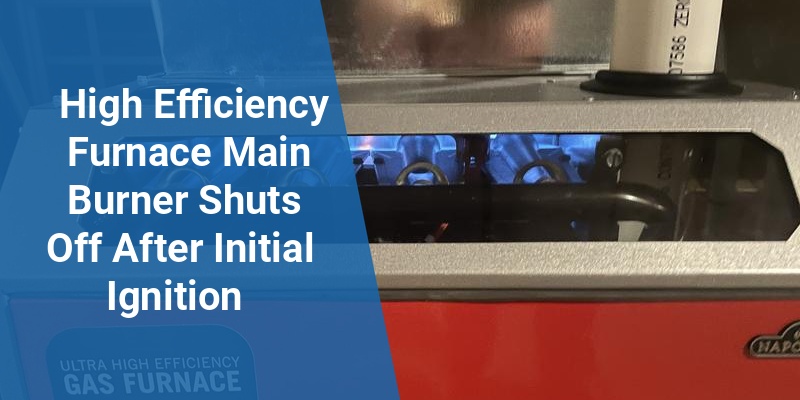High efficiency furnaces are a staple in many American homes, offering better energy savings and environmental benefits. However, a common issue homeowners face is when the main burner shuts off shortly after initial ignition. This problem can disrupt heating efficiency and comfort during colder months. Understanding the primary reasons behind this malfunction and practical troubleshooting steps can help restore furnace operation and maintain home warmth.
| Potential Cause | Description | Recommended Action |
|---|---|---|
| Dirty Flame Sensor | Accumulated residue prevents accurate flame detection, causing shutdown. | Clean or replace flame sensor to restore proper function. |
| Faulty Thermostat | Incorrect temperature readings or communication errors with furnace. | Test and recalibrate or replace if necessary. |
| Restricted Gas Supply | Insufficient gas flow leads to unstable flame and shutdown. | Check gas valves and lines for blockages or leaks. |
| Pressure Switch Issues | Pressure switch detects combustion air flow; malfunction causes safety shutoff. | Inspect and replace malfunctioning switch. |
| Ventilation Problems | Blocked vents or flue prevent proper exhaust of combustion gases. | Clear vents and ensure proper exhaust air flow. |
How High Efficiency Furnaces Work and Why Main Burner Ignition Is Critical
High efficiency furnaces operate by extracting maximum heat from combustion gases before expelling them, often utilizing secondary heat exchangers and sealed combustion chambers. The main burner ignition initiates the heating cycle, producing a steady flame to warm the air circulated through a home’s ductwork.
If the main burner shuts off after initial ignition, the furnace cannot sustain heat output, disrupting comfort and increasing energy consumption. This shutdown is typically a safety response by the furnace control system to prevent potential hazards such as gas leaks or incomplete combustion.
Primary Causes of Main Burner Shutoff After Ignition
Flame Sensor Malfunction
The flame sensor’s role is to detect the presence of a flame and signal the furnace control board to keep the gas valve open. A dirty or corroded flame sensor can fail to detect the flame, causing the system to shut off the main burner as a precaution. This is one of the most common reasons for burner shutdowns in high efficiency furnaces.
Thermostat and Control Board Issues
Errors in thermostat signals or problems within the furnace control board can cause premature shutdown of the burner. Faulty wiring, signal misinterpretation, or sensor malfunctions may interrupt the heating cycle.
Gas Supply and Pressure Problems
Inadequate gas pressure or interrupted supply affects burner operation. If the burner flame becomes unstable or goes out, the system will automatically shut down to avoid uncontrolled gas flow, preventing dangerous conditions.
Blocked Venting and Exhaust Problems
High efficiency furnaces rely on proper venting to expel combustion gases safely. Any blockage or restriction in the vent pipes or flues can cause pressure to build up, triggering a pressure switch to shut off the burner for safety reasons.
Call 888-906-9139 for Free Local HVAC Quotes – No Obligation, Just Savings!
Pressure Switch Failure
The pressure switch confirms that the inducer motor is functioning and that proper airflow is established before ignition. If the switch fails or does not detect expected pressure, it can result in the burner shutting off immediately after ignition.
Diagnostic Steps to Address Burner Shutoff Issues
- Inspect and Clean the Flame Sensor: Remove and gently clean the flame sensor with fine sandpaper or steel wool, removing any residue that hinders flame detection.
- Check Thermostat Settings and Wiring: Verify thermostat calibration and ensure secure wiring connections to prevent erratic signals.
- Examine Gas Supply Lines and Valves: Look for leaks, blockages, or pressure inconsistencies; contact a professional if issues are suspected.
- Evaluate Venting and Pressure Switch Operation: Clear vents of obstructions and test the pressure switch with appropriate tools or replace it if faulty.
- Professional Furnace Inspection: If basic checks fail, engage a licensed HVAC technician for advanced diagnostics and repairs.
Preventative Maintenance for Reliable Furnace Performance
Implementing regular maintenance can significantly reduce burner shutoff problems. Key maintenance practices include:
- Annual Furnace Tune-Up: Professional inspection ensures all components are working correctly and safely.
- Routine Flame Sensor Cleaning: Scheduled cleaning helps maintain consistent flame detection.
- Filter Replacement: Clean air filters improve airflow and reduce strain on system components.
- Vent Inspection: Regular checks prevent dangerous blockages and ensure proper combustion.
- Thermostat Upkeep: Ensure thermostat calibration and replace batteries or units as needed.
Common Safety Features that Cause Burner Shutoff
High efficiency furnaces are built with safety mechanisms designed to protect users and property. The burner shutoff after ignition often results from such features including:
| Safety Feature | Function | Effect on Burner |
|---|---|---|
| Flame Roll-Out Switch | Detects flames outside combustion area to prevent fire hazards. | Shuts off burner if flame escapes heat exchanger. |
| Limit Switch | Monitors furnace temperature to prevent overheating. | Triggers burner shutdown if temperature is too high. |
| Pressure Switch | Ensures proper airflow and vent operation. | Prevents burner operation if conditions are unsafe. |
| Flame Sensor | Detects flame presence to confirm combustion. | Shuts burner if flame is lost. |
Energy Efficiency Implications of Burner Shutoff Problems
When burners repeatedly shut off after ignition, the furnace cycles inefficiently, causing higher energy bills and uneven heating. Prolonged malfunction without repair can lead to increased wear on components, higher repair costs, and reduced furnace lifespan. Ensuring consistent burner operation is essential for maximizing the benefits of a high efficiency heating system.
When to Call a Professional HVAC Technician
While some troubleshooting can be performed by homeowners, issues such as gas pressure irregularities, control board faults, or venting complications require expert evaluation. If the main burner shuts off persistently after ignition despite basic maintenance, contact a licensed HVAC professional to ensure safe and effective repairs.
